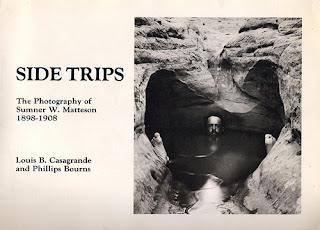Sumner W. Matteson, Jr. was born in 1867 in Decorah, Iowa, the second of six children. In 1884 he entered the University of Minnesota where he joined the Chi Psi fraternity, played on the tennis team, and edited the first Gopher yearbook. He graduated with a B.S. from the University of Minnesota in 1888 -- the very year that Kodak roll film was introduced.
For the next several years it appeared that Matteson would follow his father, uncle and brothers into the world of banking. He clerked two years at the family bank in Decorah, followed by another three years in Great Falls, Montana at the bank where his older brother Herbert was head cashier. Yet in 1895, the year his father died, Matteson broke with family tradition and became the St. Paul agent for the Overman Wheel Company, makers of the popular Victor bicycle.
After only a year of selling Victor bicycles in St. Paul, Matteson moved to Colorado to manage the Overman operation in Denver. Besides selling Victor bicycles, the Denver Branch of the Overman Wheel Company also carried a complete line of Kodak cameras and Kodak supplies. Matteson soon combined the two facets of his business, taking his camera on his bicycle excursions.
By 1899 he was calling himself an "amateur photographer," so when the Overman Wheel Company pulled out of Denver in 1899, Matteson was already embarked on his new career as a "traveling correspondent."
From 1898 to 1908 Matteson crisscrossed North America taking photographs. Primarily a photojournalist, Matteson charmed his way into other people's work places and social celebrations. He produced some of the earliest photographic essays on the changing American West. Between 1898 and 1901 he photographed the elusive Ute Indians, the cliff dwellings of Mesa Verde, and the life and rites of Pueblo Indians in New Mexico and Arizona. In 1904 Matteson spent four months traveling the length of Cuba. In 1905 and 1906 he was in Montana to photograph the Fourth of July celebrations at the Ft. Belknap Reservation and the ranch life of the Flathead Indians. In 1907 Matteson spent 10 months in Mexico photographing old churches, Peons, ruins, and fiestas. During the Summer of 1908 he toured the Pacific Coast from San Francisco north to Seattle and Vancouver photographing fishermen and loggers.
In 1909 Matteson settled in Milwaukee -- perhaps because he had tired of traveling, perhaps because he needed a steady income -- and worked as a bookkeeper for the Milwaukee Coke and Gas Company then for the First National Bank. But he did not give up photography completely. He photographed Milwaukee. The Milwaukee River was one of his favorite settings: People skating, harvesting ice, swimming, and canoeing.

For tons more of his amazing photographs, view the archive here.






















This is a good representation of areas of Sumner W. Matteson's photographic opus. When the book, "SIDE TRIPS" was published, little was known about his work in Mexico. For 30+ years since, I have studied, researched and hunted for Matteson's photographs of Mexico from 1907 and 1920. Matteson died in Mexico City in Oct 1920 and his complete Mexico opus was purchased a short time later by "Mexico's Famous photographer" Hugo Brehme. Today (everyday) one can buy any number of "Brehme" postcards, signed prints and even his two rare photo books of photogravures of Mexico that use many photos made by Matteson's in 1907 and 1920. When he died, none of his negatives and none of his prints were returned to the Matteson family in the USA So, if you really enjoy Hugo Brehme's contribution to the world of Mexico photography, you need to thank Sumner W. Matteson, Junior for his excellent negatives. Brehme gives himself credit for them all. Talk about plagiarism, Ha! There's a book a-comin that has been too long in the works.
ReplyDelete